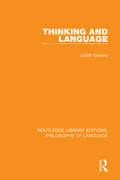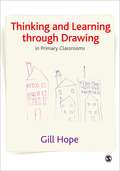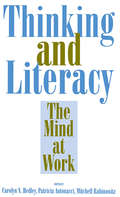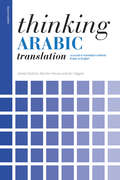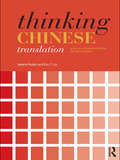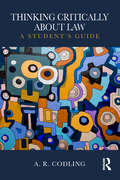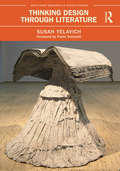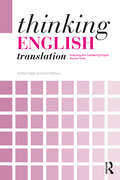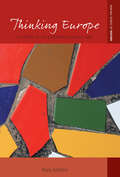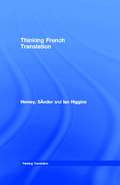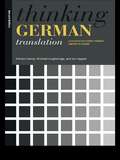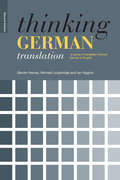- Table View
- List View
Thinking and Language
by Judith GreeneOriginally published in 1875, this book discusses thinking and language and traces the development of different pscyological approaches, assessing their theoretical significance and the experimental evidence behind them. It ends by drawing together the various lines of argument to arrive at some general conclusions about language and thought, since it clearly emerges that the two are inextricably linked.
Thinking and Language: Topics In Cognitive Psychology (Psychology Library Editions: Memory Ser.)
by Judith GreeneOriginally published in 1875, this book discusses thinking and language and traces the development of different pscyological approaches, assessing their theoretical significance and the experimental evidence behind them. It ends by drawing together the various lines of argument to arrive at some general conclusions about language and thought, since it clearly emerges that the two are inextricably linked.
Thinking and Learning Through Drawing: In Primary Classrooms
by Mrs Gill Hope'The text is clear and accessible and gives a fascinating overview of how drawing can help children to learn and understand the thinking of others…It is highly recommended for all students and practitioners interested in understanding more about how children express their ideas and theories about the world' - Early Years Update 'This book is an invaluable resource for anyone who recognises the potential of 'drawing' as an essential element for developing thinking and learning in the Primary Classroom...and a 'must read' for those who are sceptical!....This is a fascinating read that invokes a variety of feelings including a sense of wonder and curiosity about the many facets of drawing, which leaves you with a thirst to try out more and explore ways of releasing the untapped potential of 'drawing' in your own classroom' - thinkingclassroom.co.uk Children use drawing as a means through which they create, develop, communicate and record their thoughts and ideas. Whether it's to play, or to express feelings and meaning, drawing enables them to learn about the world, explore their imaginations, and to invent and present new ideas. With an extensive background in teaching and researching children's uses of drawing, Gill Hope describes the ways in which multiple forms of drawing are used by Primary school children. She explains why it should be actively promoted as a means of supporting thinking and learning across a wide range of subject areas, and provides practical support for teachers. Demonstrating the importance of drawing, and combining a thematic approach with practical guidance, this informative and enjoyable book: - widens teachers' understanding of the multiple uses of drawing; - shows how children can be guided to use it to support thinking and learning; - explores the range of applications in which drawing can be used across all areas of the curriculum; - looks to the future and at the ever increasing importance of graphic literacy. Providing a fresh insight into the uses of drawing as a powerful tool which supports children's thinking and learning, this book will be of interest to everyone involved in the development of children's capabilities, including teachers, student teachers and teaching assistants.
Thinking and Literacy: The Mind at Work
by Carolyn N. Hedley Patricia Antonacci Mitchell RabinowitzThis volume explores higher level, critical, and creative thinking, as well as reflective decision making and problem solving -- what teachers should emphasize when teaching literacy across the curriculum. Focusing on how to encourage learners to become independent thinking, learning, and communicating participants in home, school, and community environments, this book is concerned with integrated learning in a curriculum of inclusion. It emphasizes how to provide a curriculum for students where they are socially interactive, personally reflective, and academically informed. Contributors are authorities on such topics as cognition and learning, classroom climates, knowledge bases of the curriculum, the use of technology, strategic reading and learning, imagery and analogy as a source of creative thinking, the nature of motivation, the affective domain in learning, cognitive apprenticeships, conceptual development across the disciplines, thinking through the use of literature, the impact of the media on thinking, the nature of the new classroom, developing the ability to read words, the bilingual, multicultural learner, crosscultural literacy, and reaching the special learner. The applications of higher level thought to classroom contexts and materials are provided, so that experienced teacher educators, and psychologists are able to implement some of the abstractions that are frequently dealt with in texts on cognition. Theoretical constructs are grounded in educational experience, giving the volume a practical dimension. Finally, appropriate concerns regarding the new media, hypertext, bilingualism, and multiculturalism as they reflect variation in cognitive experience within the contexts of learning are presented.
Thinking and Literacy: The Mind at Work
by Carolyn N. Hedley Patricia Antonacci Mitchell RabinowitzThis volume explores higher level, critical, and creative thinking, as well as reflective decision making and problem solving -- what teachers should emphasize when teaching literacy across the curriculum. Focusing on how to encourage learners to become independent thinking, learning, and communicating participants in home, school, and community environments, this book is concerned with integrated learning in a curriculum of inclusion. It emphasizes how to provide a curriculum for students where they are socially interactive, personally reflective, and academically informed. Contributors are authorities on such topics as cognition and learning, classroom climates, knowledge bases of the curriculum, the use of technology, strategic reading and learning, imagery and analogy as a source of creative thinking, the nature of motivation, the affective domain in learning, cognitive apprenticeships, conceptual development across the disciplines, thinking through the use of literature, the impact of the media on thinking, the nature of the new classroom, developing the ability to read words, the bilingual, multicultural learner, crosscultural literacy, and reaching the special learner. The applications of higher level thought to classroom contexts and materials are provided, so that experienced teacher educators, and psychologists are able to implement some of the abstractions that are frequently dealt with in texts on cognition. Theoretical constructs are grounded in educational experience, giving the volume a practical dimension. Finally, appropriate concerns regarding the new media, hypertext, bilingualism, and multiculturalism as they reflect variation in cognitive experience within the contexts of learning are presented.
Thinking Arabic Translation: A Course in Translation Method: Arabic to English (Thinking Translation)
by James Dickins Sándor Hervey Ian HigginsThinking Arabic Translation is an indispensable book for linguists who want to develop their Arabic-to-English translation skills. Clear explanations, discussions, examples and exercises enable students to acquire the skills necessary for tackling a broad range of translation problems. The book has a practical orientation, addressing key issues for translators, such as cultural differences, genre, and revision and editing. It is a book on translation method, drawing on a range of notions from linguistics and translation theory to encourage thoughtful consideration of possible solutions to practical problems. This new edition includes: • new material in almost all chapters • a new chapter on parallelism • two new chapters on technical translation: botanical and Islamic finance texts • new and up-to-date examples from all types of translation, covering broad issues that have emerged in the Arab world in recent years • texts drawn from a wide variety of writing types, including newspapers, prose fiction, poetry, tourist material, scientific texts, financial texts, recipes, academic writing, constitutions and political speeches • at least three full-length practical translation exercises in each chapter to complement the discussions and consolidate learning. In addition to the updated Tutor’s Handbook, a Supplement, containing textual material and practical exercises aimed at further developing the translation issues discussed in the main text, and a Tutor’s Handbook to the Supplement, are available at www.routledge.com/cw/dickins. Thinking Arabic Translation is key reading for advanced students wishing to perfect their language skills or considering a career in translation.
Thinking Barcelona: Ideologies of a Global City (Contemporary Hispanic and Lusophone Cultures #7)
by Edgar IllasThinking Barcelona studies the ideological work that redefined Barcelona during the 1980s and adapted the city to a new economy of tourism, culture, and services. The 1992 Olympic Games offered to the municipal government a double opportunity to establish an internal consensus and launch Barcelona as a happy combination of European cosmopolitanism and Mediterranean rootedness. The staging of this municipal “euphoric postpolitics,” which entailed an extensive process of urban renewal, connects with the similarly exultant contexts of a reviving Catalan nation, post-transitional Spain, and post-Cold War globalization. The transformation of Barcelona, in turn, contributed to define the ideologies of globalization, as the 1992 Games were among the first global mega-events that celebrated the neoliberal “end of history.” Three types of materials are examined: political speeches and scripts of the Olympic ceremonies, with special focus on Xavier Rubert de Ventós’s screenplay for the reception of the flame in Empúries; the urban renewal of Barcelona directed by architect Oriol Bohigas; and fictional narratives by Quim Monzó, Francisco Casavella, Eduardo Mendoza, and Sergi Pàmies. This juxtaposition of heterogeneous materials pursues some type of postdisciplinary decoding linked to a strictly Marxist premise: the premise that correlations between different superstructural elements shed light on the economic instance. In this study, Barcelona emerges as a singular conjuncture overdetermined by global capitalism, but is also a space to reflect on three main problematics of postmodern globalization: the spectralization of the social in a fully commodified world; the contradiction between cosmopolitanism and the state; and the vanishing essence of the city.
Thinking Chinese Translation: Chinese to English
by Valerie Pellatt Eric T. LiuThinking Chinese Translation is a practical and comprehensive course for advanced undergraduates and postgraduate students of Chinese. Thinking Chinese Translation explores the ways in which memory, general knowledge, and creativity (summed up as ‘schema’) contribute to the linguistic ability necessary to create a good translation. The course develops the reader’s ability to think deeply about the texts and to produce natural and accurate translations from Chinese into English. A wealth of relevant illustrative material is presented, taking the reader through a number of different genres and text types of increasing complexity including: technical, scientific and legal texts journalistic and informative texts literary and dramatic texts. Each chapter provides a discussion of the issues of a particular text type based on up-to-date scholarship, followed by practical translation exercises. The chapters can be read independently as research material, or in combination with the exercises. The issues discussed range from the fine detail of the text, such as punctuation, to the broader context of editing, packaging and publishing translations. Major aspects of teaching and learning translation, such as collaboration, are also covered. Thinking Chinese Translation is essential reading for advanced undergraduate and postgraduate students of Chinese and translation studies. The book will also appeal to a wide range of language students and tutors through the general discussion of the principles and purpose of translation.
Thinking Chinese Translation: Chinese to English
by Valerie Pellatt Eric T. LiuThinking Chinese Translation is a practical and comprehensive course for advanced undergraduates and postgraduate students of Chinese. Thinking Chinese Translation explores the ways in which memory, general knowledge, and creativity (summed up as ‘schema’) contribute to the linguistic ability necessary to create a good translation. The course develops the reader’s ability to think deeply about the texts and to produce natural and accurate translations from Chinese into English. A wealth of relevant illustrative material is presented, taking the reader through a number of different genres and text types of increasing complexity including: technical, scientific and legal texts journalistic and informative texts literary and dramatic texts. Each chapter provides a discussion of the issues of a particular text type based on up-to-date scholarship, followed by practical translation exercises. The chapters can be read independently as research material, or in combination with the exercises. The issues discussed range from the fine detail of the text, such as punctuation, to the broader context of editing, packaging and publishing translations. Major aspects of teaching and learning translation, such as collaboration, are also covered. Thinking Chinese Translation is essential reading for advanced undergraduate and postgraduate students of Chinese and translation studies. The book will also appeal to a wide range of language students and tutors through the general discussion of the principles and purpose of translation.
Thinking Critically About Law: A Student's Guide
by A. R. CodlingSo you’ve arrived at university, you’ve read the course handbook and you’re ready to learn the law. But is knowing the law enough to get you the very best marks? And what do your lecturers mean when they say you need to develop critical and analytical skills? When is it right to put your own views forward? What are examiners looking for when they give feedback to say that your work is too descriptive? This book explores what it means to think critically and offers practical tips and advice for students to develop the process, skill and ability of thinking critically while studying law. The book investigates the big questions such as: What is law? and What is ‘thinking critically’? How can I use critical thinking to get better grades in assessments? What is the role of critical thinking in the work place? These questions and more are explored in Thinking Critically About Law. Whether you have limited prior experience of critical thinking or are looking to improve your performance in assessments, this book is the ideal tool to help you enhance your capacity to question, challenge, reflect and problematize what you learn about the law throughout your studies and beyond.
Thinking Critically About Law: A Student's Guide
by A. R. CodlingSo you’ve arrived at university, you’ve read the course handbook and you’re ready to learn the law. But is knowing the law enough to get you the very best marks? And what do your lecturers mean when they say you need to develop critical and analytical skills? When is it right to put your own views forward? What are examiners looking for when they give feedback to say that your work is too descriptive? This book explores what it means to think critically and offers practical tips and advice for students to develop the process, skill and ability of thinking critically while studying law. The book investigates the big questions such as: What is law? and What is ‘thinking critically’? How can I use critical thinking to get better grades in assessments? What is the role of critical thinking in the work place? These questions and more are explored in Thinking Critically About Law. Whether you have limited prior experience of critical thinking or are looking to improve your performance in assessments, this book is the ideal tool to help you enhance your capacity to question, challenge, reflect and problematize what you learn about the law throughout your studies and beyond.
Thinking Design Through Literature (Routledge Research in Design Studies)
by Susan YelavichThis book deploys literature to explore the social lives of objects and places. The first book of its kind, it embraces things as diverse as escalators, coins, skyscrapers, pottery, radios, and robots, and encompasses places as various as home, country, cities, streets, and parks. Here, fiction, poetry, and literary non-fiction are mined for stories of design, which are paired with images of contemporary architecture and design. Through the work of authors such as César Aires, Nicholson Baker, Lydia Davis, Orhan Pamuk, and Virginia Woolf, this book shows the enormous influence that places and things exert in the world.
Thinking Design Through Literature (Routledge Research in Design Studies)
by Susan YelavichThis book deploys literature to explore the social lives of objects and places. The first book of its kind, it embraces things as diverse as escalators, coins, skyscrapers, pottery, radios, and robots, and encompasses places as various as home, country, cities, streets, and parks. Here, fiction, poetry, and literary non-fiction are mined for stories of design, which are paired with images of contemporary architecture and design. Through the work of authors such as César Aires, Nicholson Baker, Lydia Davis, Orhan Pamuk, and Virginia Woolf, this book shows the enormous influence that places and things exert in the world.
Thinking English Translation: Analysing and Translating English Source Texts (Thinking Translation)
by Stella Cragie Ann PattisonThinking English Translation is a practical guide to analysing and translating English source texts. Section I focuses on pre-translation analysis where students are guided to consider the features of a variety of English texts and the various implications for translation into other languages. Section II examines language variety in English in more detail and provides strategies for dealing with translation challenges in a wide range of text types. Thinking English Translation gives students a framework for a better understanding of how to approach source texts in order to tackle translation assignments, whether in class or in the workplace, with confidence. Stella Cragie a Qualified Member of the Institute of Translation and Interpreting, and former Principal Lecturer in Translation at the University of Westminster, is now a freelance translator. Ann Pattison is a former Senior Lecturer in Translation at the University of Westminster and now works as a freelance translator, editor and writer.
Thinking English Translation: Analysing and Translating English Source Texts (Thinking Translation)
by Stella Cragie Ann PattisonThinking English Translation is a practical guide to analysing and translating English source texts. Section I focuses on pre-translation analysis where students are guided to consider the features of a variety of English texts and the various implications for translation into other languages. Section II examines language variety in English in more detail and provides strategies for dealing with translation challenges in a wide range of text types. Thinking English Translation gives students a framework for a better understanding of how to approach source texts in order to tackle translation assignments, whether in class or in the workplace, with confidence. Stella Cragie a Qualified Member of the Institute of Translation and Interpreting, and former Principal Lecturer in Translation at the University of Westminster, is now a freelance translator. Ann Pattison is a former Senior Lecturer in Translation at the University of Westminster and now works as a freelance translator, editor and writer.
Thinking Europe: A History of the European Idea since 1800 (Making Sense of History #46)
by Mats AndrénPresenting a new historical narrative on European integration and identity this title examines how the concept of Europe has been entangled in a dynamic and dramatic tension between calls for unity and arguments for borders and division. Through an in-depth intellectual history of the idea of Europe, Mats Andren interrogates the concept of integration and more recent debates surrounding European identity across the nineteenth and early twentieth centuries and the post-war period. Applying a broad range of original sources this unique work will be key reading for students and researchers studying European History, European Studies, Political History and related fields.
Thinking Europe: A History of the European Idea since 1800 (Making Sense of History #46)
by Mats AndrénPresenting a new historical narrative on European integration and identity this title examines how the concept of Europe has been entangled in a dynamic and dramatic tension between calls for unity and arguments for borders and division. Through an in-depth intellectual history of the idea of Europe, Mats Andren interrogates the concept of integration and more recent debates surrounding European identity across the nineteenth and early twentieth centuries and the post-war period. Applying a broad range of original sources this unique work will be key reading for students and researchers studying European History, European Studies, Political History and related fields.
Thinking Europe: A History of the European Idea since 1800 (Making Sense of History #46)
by Mats AndrénPresenting a new historical narrative on European integration and identity this title examines how the concept of Europe has been entangled in a dynamic and dramatic tension between calls for unity and arguments for borders and division. Through an in-depth intellectual history of the idea of Europe, Mats Andren interrogates the concept of integration and more recent debates surrounding European identity across the nineteenth and early twentieth centuries and the post-war period. Applying a broad range of original sources this unique work will be key reading for students and researchers studying European History, European Studies, Political History and related fields.
Thinking French Translation: A Course In Translation Method-french To English (Thinking Translation)
by Sándor Hervey Ian HigginsThe new edition of this popular course in translation from French into English offers a challenging practical approach to the acquisition of translation skills, with clear explanations of the theoretical issues involved. A variety of translation issues are considered including:*cultural differences*register and dialect*genre*revision and editing.The course now covers texts from a wide range of sources, including:*journalism and literature*commercial, legal and technical texts*songs and recorded interviews.This is essential reading for advanced undergraduates and postgraduate students of French on translation courses. The book will also appeal to wide range of language students and tutors.
Thinking French Translation (Thinking Translation)
by Sándor Hervey Ian HigginsThe new edition of this popular course in translation from French into English offers a challenging practical approach to the acquisition of translation skills, with clear explanations of the theoretical issues involved. A variety of translation issues are considered including:*cultural differences*register and dialect*genre*revision and editing.The course now covers texts from a wide range of sources, including:*journalism and literature*commercial, legal and technical texts*songs and recorded interviews.This is essential reading for advanced undergraduates and postgraduate students of French on translation courses. The book will also appeal to wide range of language students and tutors.
Thinking French Translation (Thinking Translation)
by Sándor Hervey Ian HigginsThe new edition of this popular course in translation from French into English offers a challenging practical approach to the acquisition of translation skills, with clear explanations of the theoretical issues involved. A variety of translation issues are considered including:*cultural differences*register and dialect*genre*revision and editing.The course now covers texts from a wide range of sources, including:*journalism and literature*commercial, legal and technical texts*songs and recorded interviews.This is essential reading for advanced undergraduates and postgraduate students of French on translation courses. The book will also appeal to wide range of language students and tutors.A tutors' handbook offering invaluable guidance on how to use the text is available for free download at http://www.routledge.com/cw/thinkingtranslation/
Thinking French Translation (Thinking Translation)
by Sándor Hervey Ian HigginsThe new edition of this popular course in translation from French into English offers a challenging practical approach to the acquisition of translation skills, with clear explanations of the theoretical issues involved. A variety of translation issues are considered including:*cultural differences*register and dialect*genre*revision and editing.The course now covers texts from a wide range of sources, including:*journalism and literature*commercial, legal and technical texts*songs and recorded interviews.This is essential reading for advanced undergraduates and postgraduate students of French on translation courses. The book will also appeal to wide range of language students and tutors.A tutors' handbook offering invaluable guidance on how to use the text is available for free download at http://www.routledge.com/cw/thinkingtranslation/
Thinking German Translation: A Course in Translation Method (Thinking Translation)
by Sándor Hervey Mr Ian Higgins Ian Higgins Michael LoughridgeThinking German Translation is a comprehensive and revolutionary 20-week course in translation method offering a challenging and entertaining approach to the acquisition of translation skills. It has been fully and successfully piloted at the University of St.Andrews.Translation is presented as a problem-solving discipline. Discussion, examples and a full range of exercise work enable students to acquire the skills necessary for a broad range of translation problems.Examples are drawn from a wide variety of material from technical and commercial texts to poetry and song.Thinking German Translation is essential reading for advanced undergraduates and postgraduate students of German. The book will also appeal to a wide range of languages students and tutors through the general discussion of principles, purposes and practice of translation.
Thinking German Translation (Thinking Translation)
by Ian Higgins Sandor Hervey Michael LoughridgeThis is a comprehensive practical course in translation for advanced students of German, which focuses on improving translation quality whilst clarifying the theoretical issues involved. This second edition brings the course up-to-date, and has been fully reworked to give clearer explanations of key terms and include revised chapters on genre, compensation and revision and editing. Based on detailed analysis of translation problems, Thinking German Translation features new material taken from a wide range of sources, including: business and politics press and publicity engineering tourism literary and consumer-oriented texts. Addressing a variety of translation issues such as cultural difference, register and dialect, Thinking German Translation is essential reading for all students wishing to perfect their translation skills. It is also an excellent foundation for those considering a career in translation. Further resources, including a free teacher's handbook for the course, are available on the companion website at http://cw.routledge.com/textbooks/0415341469/resources/default.asp
Thinking German Translation: A Course In Translation Method: German To English (Thinking Translation)
by Ian Higgins Sandor Hervey Michael LoughridgeThis is a comprehensive practical course in translation for advanced students of German, which focuses on improving translation quality whilst clarifying the theoretical issues involved. This second edition brings the course up-to-date, and has been fully reworked to give clearer explanations of key terms and include revised chapters on genre, compensation and revision and editing. Based on detailed analysis of translation problems, Thinking German Translation features new material taken from a wide range of sources, including: business and politics press and publicity engineering tourism literary and consumer-oriented texts. Addressing a variety of translation issues such as cultural difference, register and dialect, Thinking German Translation is essential reading for all students wishing to perfect their translation skills. It is also an excellent foundation for those considering a career in translation. Further resources, including a free teacher's handbook for the course, are available on the companion website at http://cw.routledge.com/textbooks/0415341469/resources/default.asp
